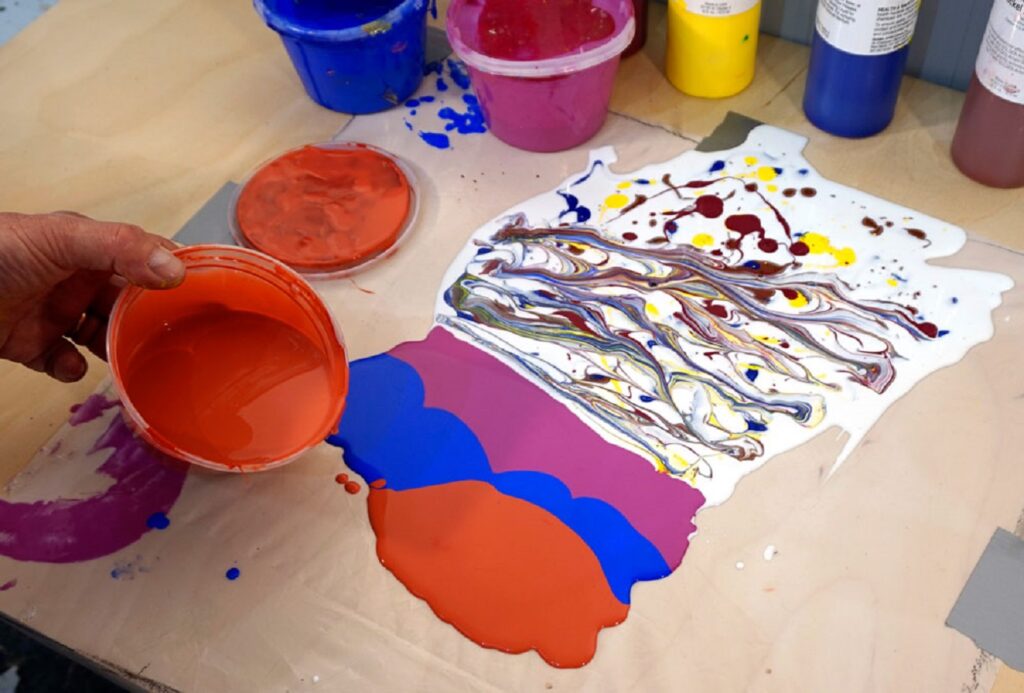Acrylic paint is a versatile and popular medium artists and hobbyists use. Its fast-drying nature and vibrant color options make it a preferred choice for various art projects.
However, sometimes acrylic paint can become sticky, making it challenging to work with and compromising the quality of your artwork.

In this article, we will explore the reasons behind sticky acrylic paint and provide useful tips on preventing and fixing this issue.
Understanding Acrylic Paint
Before diving into the specifics of sticky acrylic paint, let’s gain a basic understanding of what acrylic paint is.
Acrylic paint is made of pigment suspended in an acrylic polymer emulsion, resulting in a water-based paint that dries quickly and forms a flexible and durable film on the painting surface. It can be thinned with water or mixed with various mediums to achieve desired textures and effects.
Common Issues with Acrylic Paint
While acrylic paint offers numerous advantages, it is not without its challenges. Some common issues artists encounter with acrylic paint include color shifts during drying, brush strokes becoming visible, and the paint drying too quickly on the palette.
Another frustrating problem is when the paint becomes sticky or tacky, making it difficult to work with and leading to uneven or clumpy application.
Why Acrylic Paint Becomes Sticky?
Understanding the factors contributing to sticky acrylic paint is crucial for preventing this issue. The stickiness is often caused by the polymer particles in the paint not fully coalescing or fusing together during the drying process. This can happen for various reasons, including excessive humidity, using too much water when thinning the paint, or applying thick layers of paint that take longer to dry.
Tips to Prevent Acrylic Paint from Becoming Sticky
To prevent acrylic paint from becoming sticky, consider implementing the following tips:
Use Quality Acrylic Paint: Invest in high-quality acrylic paint from reputable brands. These paints are formulated with better binders and pigments, resulting in a more stable and reliable drying process.
Control the Environment: Avoid painting in extremely humid conditions, as high humidity can interfere with the drying process of acrylic paint. Choose a well-ventilated area with moderate temperature and humidity levels.
Moderate Water Usage: Use moderate water when thinning acrylic paint. Excessive water can disrupt the paint’s chemical balance, leading to stickiness.
Layer Thin Coats: Instead of applying thick layers of paint, build up your artwork with multiple thin coats. This allows each layer to dry more thoroughly and reduces the chances of stickiness.
Use Retarders: Acrylic paint retarders can be added to the paint to slow the drying time, giving you more control over the process and minimizing stickiness.
Storing Acrylic Paint Properly
Proper acrylic paint storage is essential to maintain its quality and prevent it from becoming sticky over time. Consider the following storage tips:
Seal Paint Tubes and Jars: Ensure that paint tubes and jars are tightly sealed after each use. This helps prevent air exposure, which can lead to the drying out and thickening of the paint.
Store in a Cool, Dry Place: Acrylic paint should be stored in a cool and dry area, away from direct sunlight and extreme temperature fluctuations. Excessive heat can cause the paint to become runny, while extreme cold can affect its consistency.
Use Moisture-Controlled Containers: Consider using moisture-controlled containers or palette systems designed specifically for acrylic paint. These containers help maintain a stable environment, preventing moisture from seeping into the paint.
How to Fix Sticky Acrylic Paint?
If you find yourself with sticky acrylic paint, there are a few steps you can take to salvage it:
Identify the Cause: Determine the possible cause of the stickiness. Was the paint applied in thick layers or a high-humidity environment? Identifying the underlying issue will guide your corrective actions.
Allow Sufficient Drying Time: Give the sticky paint additional drying time. Place the artwork in a well-ventilated area with optimal temperature and humidity conditions. This extra drying time allows the polymer particles to coalesce fully and the stickiness to resolve.
Apply a Fixative: If the stickiness persists, apply a fixative specifically formulated for acrylic paint. Follow the instructions provided by the manufacturer to ensure proper application and drying.
Sand and Repaint: In extreme cases where the stickiness cannot be resolved, you may need to sand down the affected area and repaint it gently. Remember to prime the surface before reapplying the paint to ensure better adhesion and prevent future issues.
Other Tips and Tricks for Working with Acrylic Paint
Apart from preventing and fixing sticky acrylic paint, here are a few additional tips to enhance your experience with this versatile medium:
Experiment with Mediums: Acrylic paint offers a wide range of mediums that can alter its properties, such as extending drying time, increasing transparency, or adding texture. Explore different mediums to achieve desired effects and improve workability.
Clean Brushes and Tools Properly: Properly clean your brushes and tools immediately after each use to prevent paint residue from drying and causing them to become stiff or unusable. Use water and mild soap for acrylic paint removal.
Protect Finished Artwork: Once your artwork is complete, apply a varnish or protective coating to safeguard it from dust, UV rays, and potential stickiness in the future.
Conclusion
Acrylic paint is a versatile and vibrant medium that offers many creative possibilities. By understanding the causes of sticky acrylic paint and implementing preventive measures, you can enjoy a smoother painting experience and produce high-quality artwork.
Remember to store your paint correctly, work in suitable environments, and follow the recommended techniques for fixing sticky paint. With these tips, you can unleash your creativity and create stunning acrylic masterpieces.
FAQs
Q1. Can I add water to acrylic paint to prevent stickiness?
You can add water to acrylic paint for thinning and adjusting consistency. However, it’s important to use a moderate amount of water. Excessive water can disrupt the paint’s chemical balance and contribute to stickiness.
Q2. Can I use a hairdryer to speed up the drying process of acrylic paint?
Using a hairdryer to accelerate the drying process of acrylic paint is possible, but it’s essential to exercise caution. Excessive heat can cause the paint to dry too quickly, leading to uneven textures and potential cracking. It’s best to allow the paint to air dry naturally or use a low setting on the hairdryer to speed up the process.
Q3. Can I mix different brands of acrylic paint together?
Yes, you can mix different brands of acrylic paint together. However, remember that different brands may have slight variations in color, consistency, and drying time. It’s advisable to test the compatibility of the paints on a small surface before using them for a larger project.
Q4. Can I use acrylic paint on surfaces other than canvas?
Absolutely! Acrylic paint can be used on various surfaces, including canvas, wood, paper, fabric, glass, and more. Ensure the surface is clean, dry, and properly prepared to promote better paint adhesion and longevity.
Q5. How long does acrylic paint take to dry completely?
The drying time of acrylic paint varies depending on humidity, the thickness of paint layers, and ventilation. Generally, acrylic paint dries to the touch within 20-30 minutes. However, it can take several hours or even days to dry completely, especially for thicker applications. To be safe, allow at least 24 hours for the paint to dry before varnishing or handling the artwork.







Leave a Comment
You must be logged in to post a comment.